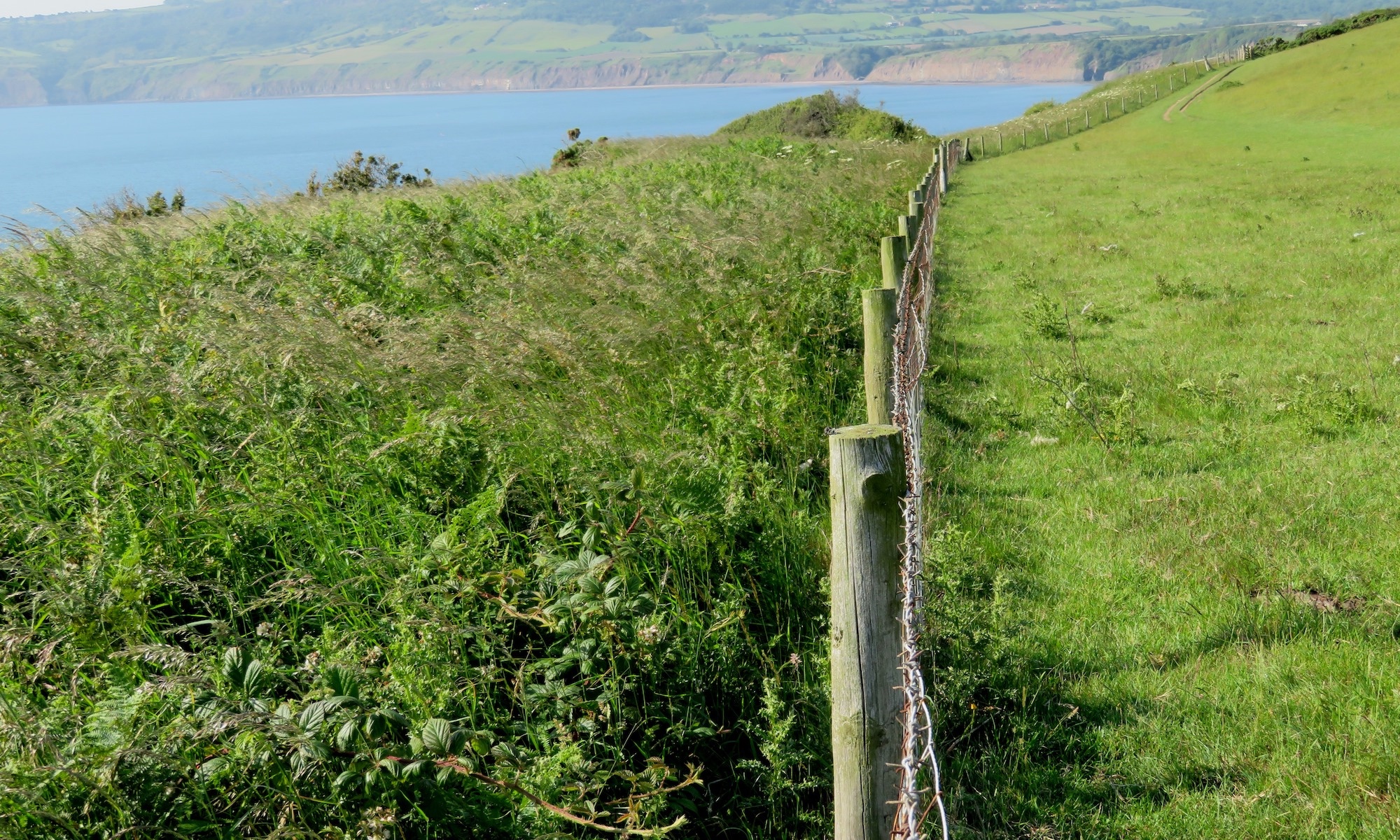by Georgina Valentine
28th July, 2022
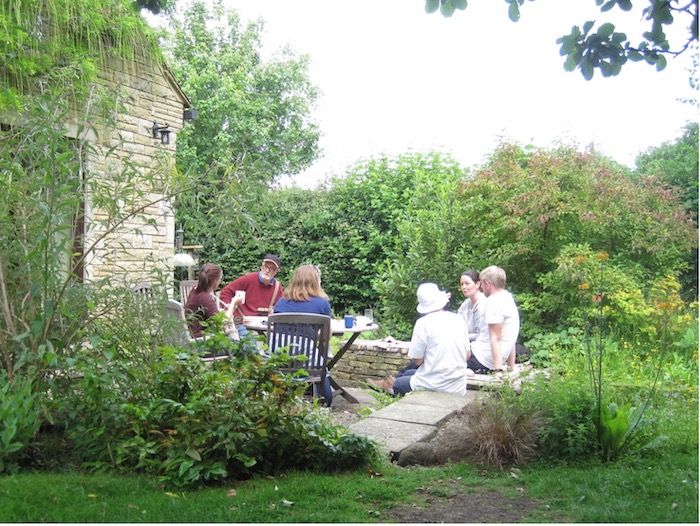
I recently attended the YRN site visit to Ben Rhydding, Ilkley, which took place towards the end of June. As a newcomer to the network I thought it would be a good opportunity to get some ideas and inspiration about what can be done in a suburban garden setting as well as meeting others from across the network. The location is in a quiet cul de sac on the edge of Ilkley overlooking gently rolling hills and farmland.
Debbie and Jeff, our hosts, were giving tours round their half acre garden which has had the benefit of chemical free & wildlife friendly gardening since they first moved there 20 years ago, with the addition of rewilding approaches for the last 3 years.
It was a beautiful sunny day and as I arrived I was met by Jeff and a small group of us chatted while the rest of the visitors arrived.
The first thing we were greeted by was a wonderfully abundant, colourful wildflower meadow verge on either side of the sloping tarmac driveway. Jeff described how, about 3 years ago, they had ‘roughened’ the surface of their grass verge with a rake to disturb the soil, before sowing a wildflower meadow mix in the autumn. This has begun to take hold and is now self-seeding each year with a mix of perennials. Lawn grass, which can be quite dominant, is being kept in check by the presence of yellow rattle, an annual which is parasitic on grass and the consequently weakened grass system allows for a greater variety of meadow species to grow.
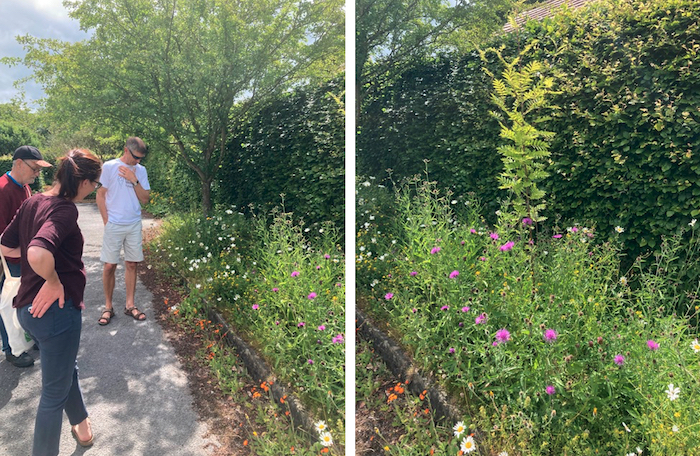
The meadow verges were in full bloom and as my botanical knowledge is rather nonexistent I was trying to catch and remember the names of some of the plants that we looked at. We found wild carrot with its feathery leaves and delicate umbrella shaped lacey white flower heads. If dug up, the roots resemble carrots, but much slimmer than the cultivated varieties. There was fox and cubs, which has bright rusty red / orange flowers in clusters (which looked to me like miniature dandelion heads) and with a stretch of the imagination could resemble a fox and her cubs, and knapweed with its purple thistle shaped flowers, clover nestling lower down, ox eye daisies with their distinctive faces and some beautiful white bell shaped flowers which is a non-native campanula that has found its way in. It’s amazing how an energy intensive, time consuming grass verge which ‘needs’ mowing can be transformed into an abundance of graceful, pollen rich flowers swaying in a gentle breeze, with fairly minimal effort. Jeff pointed out the fuzzy edge of the tarmac drive where the tarmac is beginning to disintegrate. He explained that they have decided to let these plant species continue to creep inwards. Instead of fighting the inevitable they will allow nature to do what nature does. At some point in the future they will replace the part of the drive which needs to support the weight of a vehicle with a weight bearing grid so that the entire drive becomes a permeable surface which can sustain plant life. This will be good for flood mitigation as well as biodiversity.
We passed a young rowan sapling as we headed towards the back garden. As well as producing a beautiful display of vibrant berries in the autumn, in time, this will also provide food for birds during the winter.
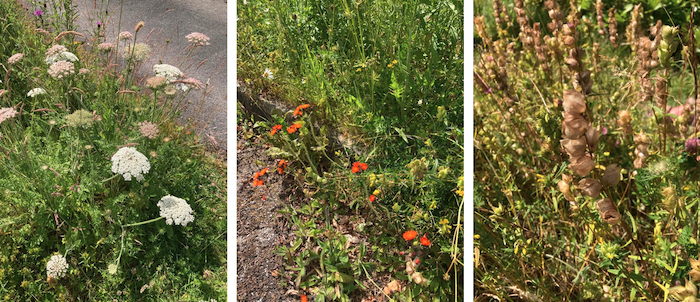
At the rear of the house there is a large Bramley apple tree, this area which was once surrounded by an unremarkable lawn is now transforming into a beautiful woodland glade. Around the mature apple, clusters of young birch trees have been planted quite close together, along with holly and other non-native but wildlife friendly species. The birch are now about 4-7 years old, the trunks about 2-3 inches diameter and, as they grow bigger, will be thinned out in rotation and replaced by saplings that Debbie pots up when they self-seed around the garden and the wood used for other purposes.
A pond has been created between the woodland glade and the house. It catches the sun and is partially shaded by the trees. The pond has a shallow side to allow amphibians, hedgehogs and birds easy access and a steep side with deeper water on the shaded woodland side. A waterproof membrane ensures that the pond remains full all year round with occasional topping up. Some marginal water plants have established themselves though most have been introduced and spread naturally.
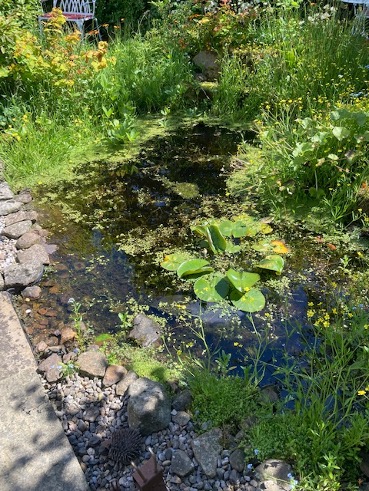
The surface of the pond was buzzing with life. Bees were pausing to drink at the shallow edge of the pond, turquoise blue damsel flies were darting here and there, and small insects and pond skaters zipping across the surface. Below the surface, to our delight we spotted newts, as well as water snails. Frogs and toads have been seen and birds and other small mammals will all be supported by the presence of even a small pond.
The hedges surrounding the garden are providing shelter and nesting for small birds and are only trimmed once a year so that they remain as undisturbed as possible. One of the hedges was planted with multiple species of native hedgerow shrubs such as hawthorn, blackthorn, field maple, hazel, holly, guelder rose, dog rose and honeysuckle. Next to it were some bird feeders including a plastic contraption resembling an upside down pudding bowl… to deter squirrels in their acrobatic efforts to plunder the bird food intended for more vulnerable small bird species.
Returning to the front of the house, which is north facing, we saw swift boxes which have been installed. With their narrow entrance holes situated fairly high up, with sufficient spacing between them they have had some activity this year. Tree sparrows have also been using some of the boxes and this helps their species too. A swift caller device has been located just below one of the boxes and when this is switched on in mornings and evenings the sound of swift calls attracts and encourages swifts to come and nest. The iconic life cycle of swifts, their ethereal, haunting calls and incredible distances they migrate leave such an unforgettable impression that is truly humbling. Debbie had also enabled access for swallows to hopefully nest in the garden shed, by removing a small section from the top of the shed door. This could be blocked up during the winter to prevent rain damage and then removed for the spring and summer seasons.
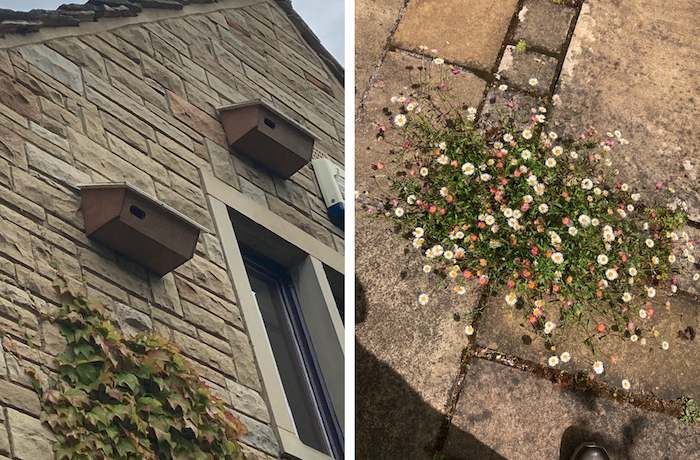
Admiring the fruit trees and the raised beds for veg growing, cleverly tilted by a few inches at an angle towards the sun we concluded our tour with a generous invitation to have tea and cake sitting by the pond. The two groups happily chatted, continuing the conversation while browsing some of the rewilding books that Debbie had brought out to show us. It was great to meet people from such a variety of ages and backgrounds, from a young man who is changing his career from graphic design to ecology, to a recently retired woman who has just started volunteering with a riverside trust and is discovering the joys and perils of waders. Most people were local, one or two had come from further afield, but what connected us was a shared vision of what can be possible when we allow nature to speak.
Imagine what could happen if everyone across the UK began to implement nature friendly practises… simply in their gardens. The biodiversity in suburban areas may in fact be far greater than large swathes of so called countryside and the area that gardens cover must be considerable.
While writing this account I looked through the rather minimal notes I had jotted down at the time and perhaps the most important one of all was something Jeff had said, “Don’t do all the stuff the same…” I can’t actually remember what he was referring to at the time but it strikes me as a great piece of advice for rewilding in general as it allows for more complex ecological interactions, greater possibilities, greater resilience and a less dogmatic, more open approach. Perhaps it’s this mindset that will, in the end be the thing that helps bring the rest of the world on board.
For my part I would like to thank Jeff and Debbie for their warm welcome and YRN for making these site visits possible. It means a lot to see rewilding in practice, to learn from others and meet like minds.
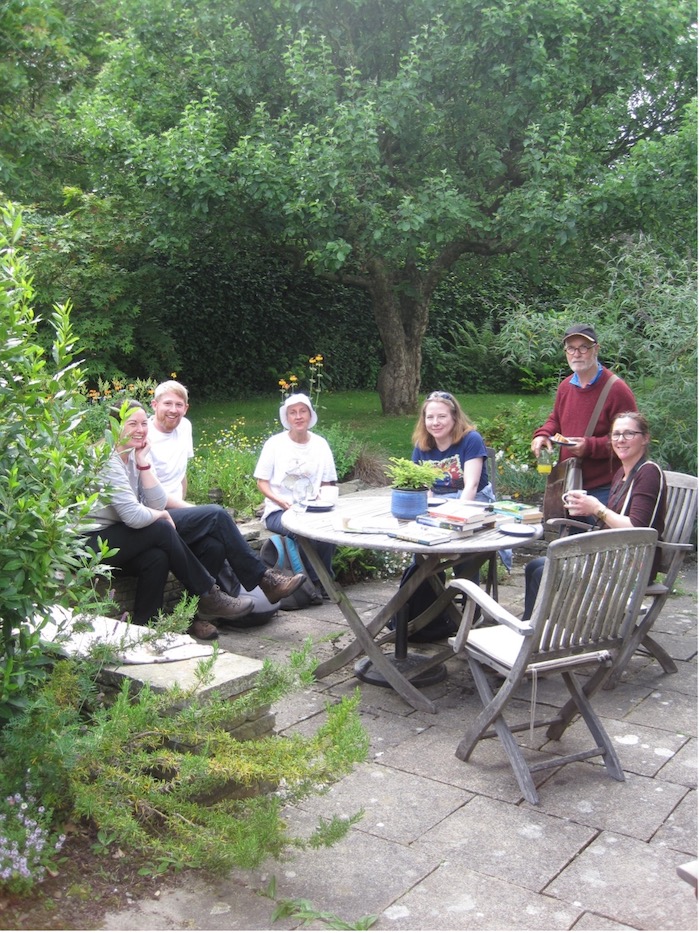
[Images: Georgina Valentine and Debbie Davitt]
